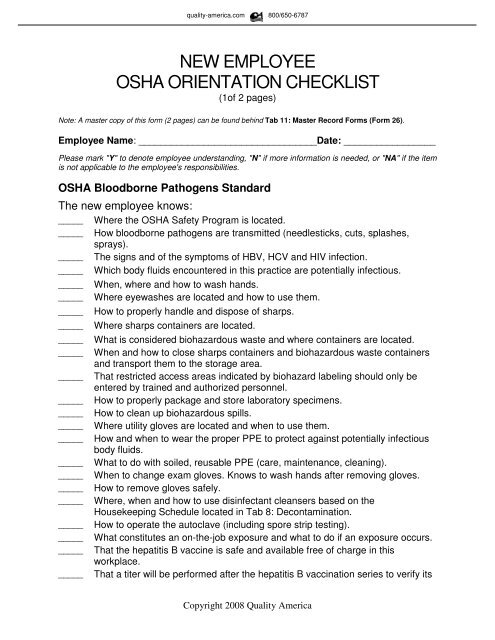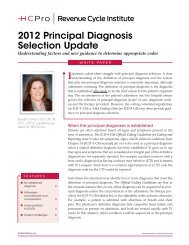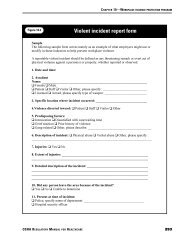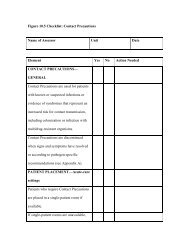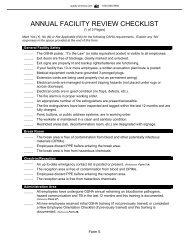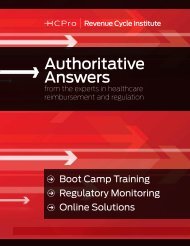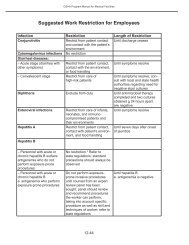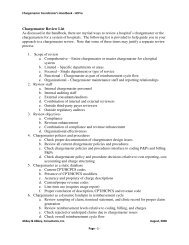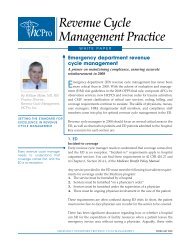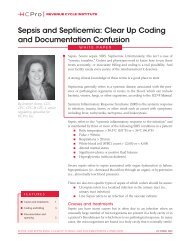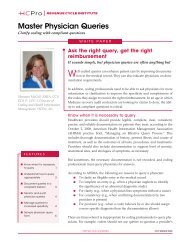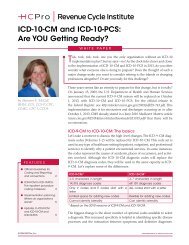NEW EMPLOYEE OSHA ORIENTATION CHECKLIST - HCPro Blogs
NEW EMPLOYEE OSHA ORIENTATION CHECKLIST - HCPro Blogs
NEW EMPLOYEE OSHA ORIENTATION CHECKLIST - HCPro Blogs
You also want an ePaper? Increase the reach of your titles
YUMPU automatically turns print PDFs into web optimized ePapers that Google loves.
quality-america.com 800/650-6787<br />
<strong>NEW</strong> <strong>EMPLOYEE</strong><br />
<strong>OSHA</strong> <strong>ORIENTATION</strong> <strong>CHECKLIST</strong><br />
(1of 2 pages)<br />
Note: A master copy of this form (2 pages) can be found behind Tab 11: Master Record Forms (Form 26).<br />
Employee Name: _________________________________Date: _________________<br />
Please mark "Y" to denote employee understanding, "N" if more information is needed, or "NA" if the item<br />
is not applicable to the employee's responsibilities.<br />
<strong>OSHA</strong> Bloodborne Pathogens Standard<br />
The new employee knows:<br />
_____<br />
_____<br />
_____<br />
_____<br />
_____<br />
_____<br />
_____<br />
_____<br />
_____<br />
_____<br />
_____<br />
_____<br />
_____<br />
_____<br />
_____<br />
_____<br />
_____<br />
_____<br />
_____<br />
_____<br />
_____<br />
_____<br />
_____<br />
Where the <strong>OSHA</strong> Safety Program is located.<br />
How bloodborne pathogens are transmitted (needlesticks, cuts, splashes,<br />
sprays).<br />
The signs and of the symptoms of HBV, HCV and HIV infection.<br />
Which body fluids encountered in this practice are potentially infectious.<br />
When, where and how to wash hands.<br />
Where eyewashes are located and how to use them.<br />
How to properly handle and dispose of sharps.<br />
Where sharps containers are located.<br />
What is considered biohazardous waste and where containers are located.<br />
When and how to close sharps containers and biohazardous waste containers<br />
and transport them to the storage area.<br />
That restricted access areas indicated by biohazard labeling should only be<br />
entered by trained and authorized personnel.<br />
How to properly package and store laboratory specimens.<br />
How to clean up biohazardous spills.<br />
Where utility gloves are located and when to use them.<br />
How and when to wear the proper PPE to protect against potentially infectious<br />
body fluids.<br />
What to do with soiled, reusable PPE (care, maintenance, cleaning).<br />
When to change exam gloves. Knows to wash hands after removing gloves.<br />
How to remove gloves safely.<br />
Where, when and how to use disinfectant cleansers based on the<br />
Housekeeping Schedule located in Tab 8: Decontamination.<br />
How to operate the autoclave (including spore strip testing).<br />
What constitutes an on-the-job exposure and what to do if an exposure occurs.<br />
That the hepatitis B vaccine is safe and available free of charge in this<br />
workplace.<br />
That a titer will be performed after the hepatitis B vaccination series to verify its<br />
Copyright 2008 Quality America
quality-america.com 800/650-6787<br />
efficacy.<br />
(New Employee <strong>OSHA</strong> Orientation Checklist, page 2 of 2)<br />
Hazard Communication<br />
The new employee knows:<br />
_____ What hazardous chemicals exist in the practice (review master list).<br />
_____ How to work safely with the above chemicals.<br />
_____ Where Material Safety Data Sheets (MSDS) are located and how to read one.<br />
_____ How to recognize signs of chemical exposure and what to do if exposure<br />
occurs.<br />
_____ How and where to sterilize or disinfect instruments and equipment.<br />
Other: _____________________________________________________________________.<br />
TB<br />
The new employee knows:<br />
_____ How TB is transmitted and policies for identifying potential TB patients.<br />
_____ The practice's relative risk of encountering patients with TB (refer to TB Risk<br />
Assessment Result Form).<br />
_____ What to do if an active TB patient enters the practice.<br />
_____ That initial TB skin testing (TST) must be performed.<br />
Other: _____________________________________________________________________.<br />
Emergencies<br />
The new employee knows:<br />
_____ Location of written emergency procedures and emergency telephone numbers.<br />
_____ Exit routes and evacuation procedures.<br />
_____ Where fire extinguishers are located and what to do in the event of a fire.<br />
Other: _____________________________________________________________________.<br />
Copyright 2008 Quality America


